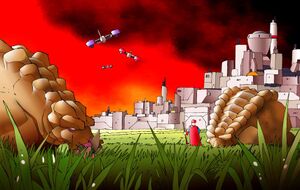Mainz
Mainz was originally known as Fort Charles and was claimed by the newly emergent Western Frontier Protectorate., with which it shared much cultural heritage. The UMF coveted the rich ranching lands around Fort Charles, however, and did not want to see the WFP move into the Marathon Basin region, which it considered its heartland. In TN 1551, the UMF moved into the region to assert its authority, with the tacit approval of the NLC — it was concerned about reigning in the WFP. Fort Charles was integrated into the Mercantile Federation and renamed itself Mainz soon thereafter. This lead to a series of nasty border wars between the UMF and WFP, but Mainz remained in Mercantile hands.
Today, the city is the center of the UMF’s ranching culture. Animal production, processing and packaging completely dominates this city’s economy. The city’s slaughterhouses process countless springers, barnabies, hoppers, snakes and cattle every year. No part of the animal is wasted. The hides are processed into leather and fur products, the meat is sold for consumption, and the bones and viscera are ground into fertilizer. Mainz is possibly the least popular tourist site in the Arctic. The city reeks of death. This stench only disappears when a breeze comes down from the nearby Westridge mountains. Most native Mainzites are oblivious to the smell under normal conditions, but even they notice it during the city’s hot, humid Spring.
Mainz is also the headquarters of MainzFood, the largest fast food conglomerate in the CNCS. Their restaurants can be found almost every neighborhood across the Arctic. MainzFood’s most widespread restaurant chains are MainzBurgers, MainzZa (pizza and sandwiches), MainzKebabs, and MainzCourse (gourmet fast food).

